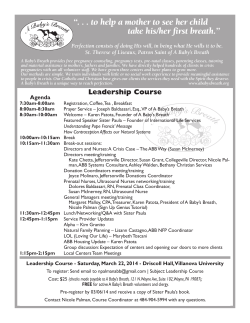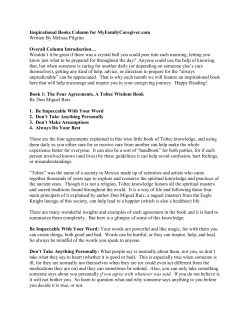
Document 62472
Mindfulness Activities for Young Children Mindfulness is difficult to define, although it can generally be conceptualised as techniques for training attention, but in a particular and purposeful way, focusing on the present moment, without the addition of judgement. When a person is experiencing- uncomfortable bodily sensations, urges to escape these sensations in some way (e.g. by avoiding), unhelpful thoughts, fears for the future, or ruminations on past negative events- their attention is sometimes so focused on these unpleasant sensations that they do not attend clearly to the present moment. This can lead to the missing of important information about situations, inaccurate interpretations of events, and therefore unwise or inappropriate behavioural decisionswhich can often lead to a cycle of anxiety and avoidance, anger, frustration, etc. Mindfulness training offers practice in keeping one’s attention in the present moment so that information can be seen objectively, with interest and compassion, and without the automatic ‘judgements’ that our minds often place on events (e.g. heart beating fast = “I must be feeling anxious” = “I can’t stand anxiety” = avoid situation = next time in same situation = heart beating fast…and round it goes!). “Living in the present, you might find that this moment is manageable, even when it is not the most wonderful moment of all” (Semple, R.J. & Lee, J). These activities can be done together, with the adult reading through the ‘script’, or recorded for the child to practice. It does make for a nice period of ‘together time’, so it is recommended that it is done together at first, and once the child is used to the activities, they can simply be reminded to practice in times of need. Remember to share your own experiences with the child during these activities! Three Mindful Breaths The first thing we are going to try is what is called “Three Mindful Breaths”. Breathing is a great thing to start practicing mindfulness with, because you can’t go anywhere without it! Find a comfortable sitting position. Sit so that you can easily and normally breathe through your nose. You just need to take your normal size breaths. You can close your eyes for this, or if you don’t feel comfortable doing that, try doing what we call “soft eyes’, which means to just look down at the floor without really focusing on anything. © T & S Bowden www.actonpurpose.com.au Page 1 of 4 I Just Want to be Me Mindfulness Activities for Young Children Now bring your attention to your breath. You can focus on the breath at your nostrilsnoticing how the air feels cool coming in and may be slightly warmer as it leaves your body. Or you can focus on your breath at your belly- feeling it rise and fall as the air enters and leaves your body. Stay focused, as best you can, on your breath. Just notice the air as it enters and leaves, enters and leaves your body. If your mind wanders, that’s okay. Simply bring your attention back to the in-breath and out-breath. Breathing in and breathing out. Your mind will naturally wander off and get lost in its thoughts. That’s okay- it’s just what minds do. Your job is to gently bring your attention back to your breath every time you notice your mind has wandered. Tell yourself “good job” for noticing, and then continue to watch your breath. Now I am going to ask you to take three normal breaths, and try and focus just on the breath for all three. Now gently start to take notice of what is happening around you. Notice your body where it touches the floor. Notice what is in the room around you. Notice what sounds you can hear. Now gently start to move your fingers and toes, and have a stretch, and let’s have a talk about what we did. • Ask the child open-ended questions such as “What did you notice while you were doing this?” “How was this sort of breathing compared with the way you normally breathe?” Mindful Smiling Find a comfortable position on the floor, lying down like you are in your bed. Close your eyes, or if you aren’t comfortable closing them, have “soft eyes” just gazing up at the ceiling without really focusing on anything. Imagine you are just waking up. Open your eyes and take a few normal breaths, noticing the breath either going in and out your nostrils, or your belly going up and down. © T & S Bowden www.actonpurpose.com.au Page 2 of 4 I Just Want to be Me Mindfulness Activities for Young Children Now slowly turn your mouth up into a smile- not a big, exaggerated smile, just a normal smile like you would give to someone you like. Notice how your lips feel- are they together? Are your teeth showing? Are they warm, cool, damp, or something else? Now notice your cheeks- how does the smile make your cheeks feel? Does it push them out? Up? Does it make them feel warm, cool, or something else? Now notice the rest of your face- does your smile change anything about your eyes, your jaw, your ears? What about your teeth and your tongue? Now bring your attention to the rest of you. When you are ready, slowly raise yourself up as if you are getting out of bed. Gently give yourself a stretch and sit back up. • Ask similar open-ended questions as above. Practice mindful smiling every morning when you wake up- if needed, put a smiley face near the bed to remind you! Making room for uncomfortable feelings When an uncomfortable feeling comes up, mindfully ‘scan’ your body to tell where the most uncomfortable sensation is. Is it in your head? Stomach? Chest? Or somewhere else? Pick the most uncomfortable sensation and really pay attention to it. Use your imagination to describe what it might look like (e.g. An uncomfortable feeling in the stomach might feel like a heavy lump of clay), feel like (texture, temperature, does it move). Now slowly take some breaths and let all the air out of your lungs with each breath, letting your lungs fill up naturally each time. With each breath, imagine the air going around and through the uncomfortable feeling, making room in your stomach/chest/etc. The feeling doesn’t have to go away- you just need to make some more space for it. Put your hand on the part of your body where the uncomfortable feeling is and feel the weight, warmth and feel of your hand comforting you. You can say something to the feeling like, “I can feel you there, but it’s okay. I can still do what is important to me like…(going to school/doing the test/doing my homework etc). I don’t like this feeling but I can make room for it and still keep going.” © T & S Bowden www.actonpurpose.com.au Page 3 of 4 I Just Want to be Me Mindfulness Activities for Young Children • • The idea behind this type of exercise is to provide children with the strategies to manage uncomfortable feelings instead of struggling against them (or avoiding situations that make them feel uncomfortable, such as school refusal), and to instead focus on what is important to them (their family/friends/etc). Often children (and adults) find that doing this type of activity does decrease the feelings- but this is not the intention of the activity! What we are aiming for is allowing uncomfortable feelings (which are a natural part of life, and also something that often comes up when we are doing something important to us) and to still keep functioning. Everyday Mindfulness Mindfulness activities can be as varied as your imagination- take the time to have ‘mindful moments’ with your child whenever possible. Some suggestions: • One minute of mindful eating during dinner • A mindful walk around the house • A mindful moment while driving • Mindfully brushing your teeth • Mindful gardening/cooking/craft time with your child • Mindful patting/grooming of a pet • Mindfully throwing a ball/dancing/moving Be aware that we don’t ALWAYS have to be ‘in the moment’ and to force mindfulness upon someone can be counter-productive! We also need time to plan, think about things that have happened etc. It’s only when we get ‘stuck’ outside the moment for too long that we miss what’s going on around us. And remember, the younger the child, the shorter the time. Even a few seconds of really being ‘in the moment’ is a good start. © T & S Bowden www.actonpurpose.com.au Page 4 of 4
© Copyright 2025





















